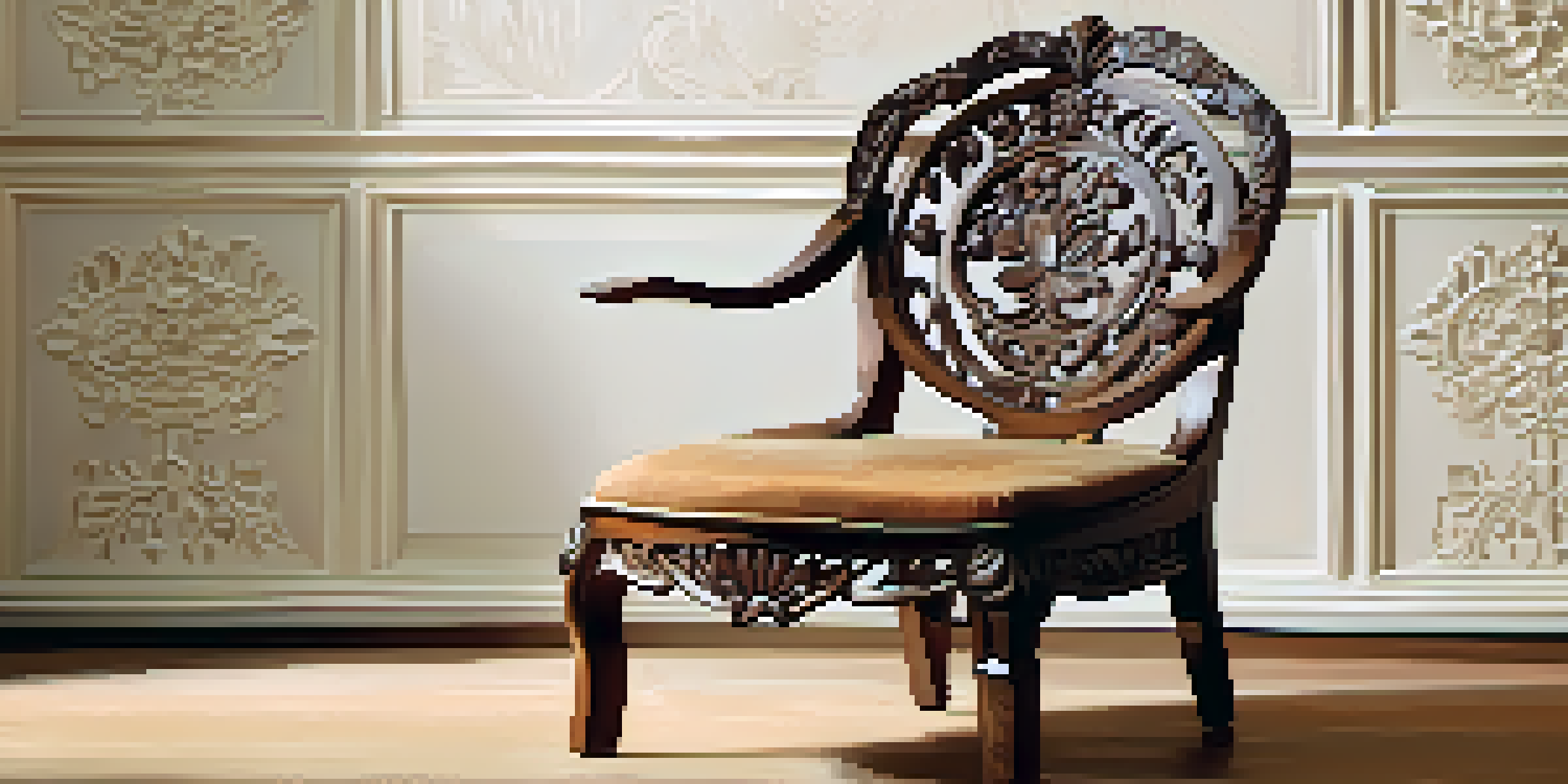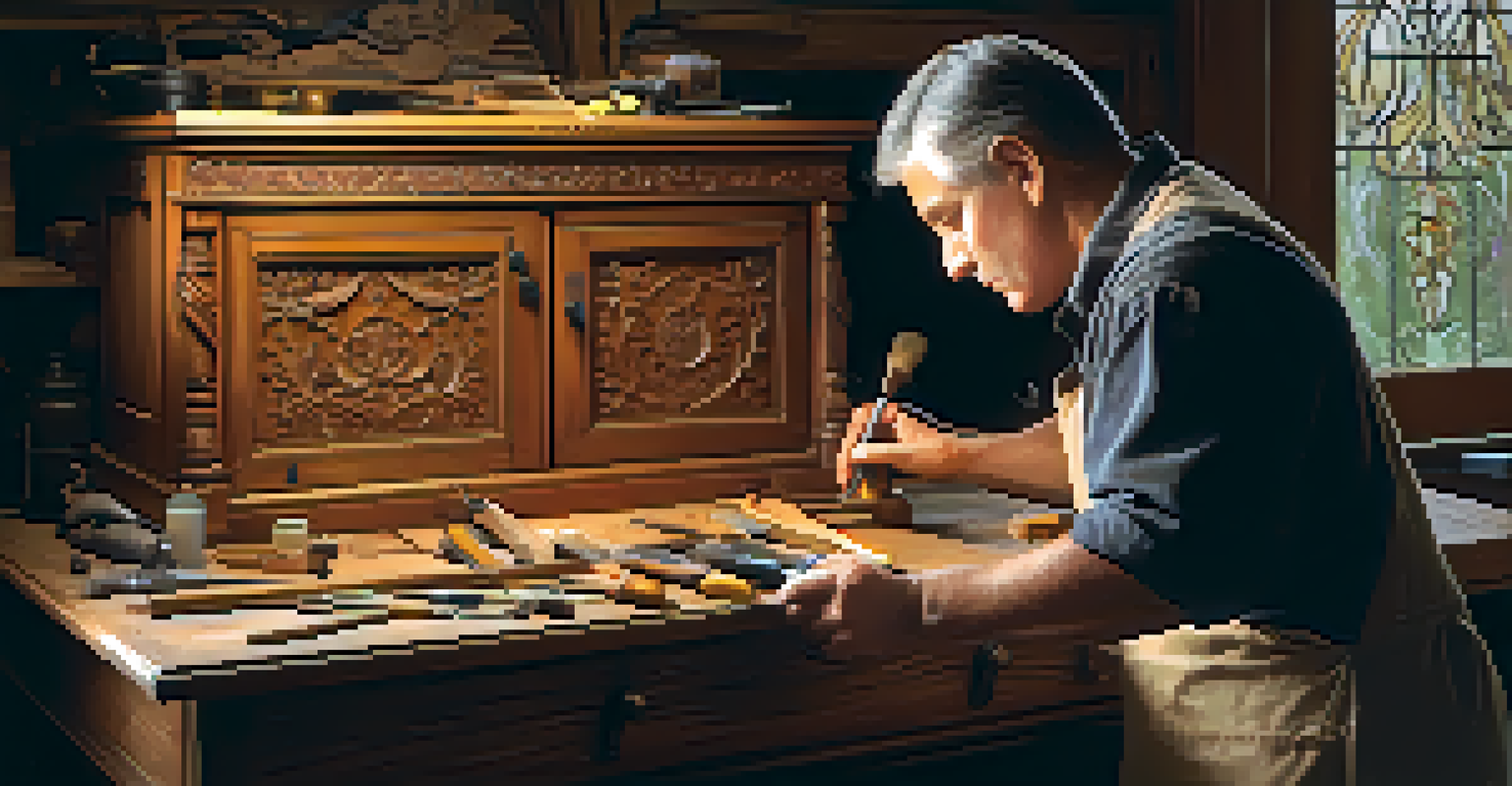Historical Significance of Carving in Furniture Restoration

Understanding the Art of Carving in Historical Furniture
Carving has been a fundamental aspect of furniture making for centuries, showcasing craftsmanship and artistry. Historically, intricate carvings often reflected the style and culture of the time, making each piece a unique representation of its era. From ornate designs in Baroque furniture to the simplicity of Shaker styles, carving tells a story beyond mere aesthetics.
Furniture is a form of architectural structure, a place where individuals can express their identity and taste through design.
The uniqueness of carved furniture also lies in its ability to convey social status and wealth. During the Renaissance, for instance, elaborate carvings were reserved for the affluent, serving as symbols of power and prestige. This historical context adds layers of meaning to furniture restoration efforts, as each carved detail can reveal a wealth of information about its original owner and the societal norms of the time.
In contemporary restoration practices, understanding these historical carvings is crucial. Craftspeople and restorers not only aim to preserve the physical integrity of these pieces but also honor their historical significance. This involves recognizing the original carving techniques and materials used, ensuring that restorations maintain authenticity and respect for the past.
The Role of Carving in Authentic Restoration Practices
When restoring antique furniture, the carvings often serve as a roadmap for authenticity. Craftspeople study the original techniques and styles to replicate the craftsmanship accurately. This dedication to detail ensures that newly restored pieces maintain their historical value and charm, setting them apart from mass-produced furniture.

For example, if a piece from the Victorian era features intricate floral motifs, restorers will strive to recreate these designs as closely as possible. This not only enhances the piece's visual appeal but also preserves its story and character. Authentic restoration celebrates the art of carving, emphasizing its importance in maintaining the integrity of the furniture.
Carving Reveals Historical Context
Intricate carvings in furniture reflect the craftsmanship and cultural values of their time, offering insights into social status and historical significance.
Moreover, the process of restoring carved furniture can spark a deeper appreciation for historical craftsmanship. As restorers uncover the stories behind the designs, they connect with the artisans of the past. This connection fosters a sense of responsibility to preserve and honor these historical artifacts for future generations.
Cultural Influences on Carving Styles in Furniture
Carving styles in furniture have been heavily influenced by various cultural movements and artistic trends throughout history. For instance, the Rococo period is known for its elaborate and playful designs, while the Arts and Crafts movement emphasized simplicity and functionality. Each style reflects the values and aesthetics of its time, providing insight into societal shifts.
The details are not the details. They make the design.
As furniture makers traveled and exchanged ideas, these cultural influences intertwined, leading to unique hybrids in carving styles. This cross-pollination of techniques resulted in furniture that is not only visually stunning but also rich in cultural significance. Understanding these influences adds depth to the restoration process, allowing restorers to appreciate the varied backgrounds of carved designs.
Restoring furniture with these cultural influences in mind ensures that the finished piece resonates with the historical context. By acknowledging and preserving these influences, restorers contribute to a broader narrative of artistic evolution and cultural heritage, making each restored piece a testament to its journey through time.
The Emotional Connection of Carving in Furniture
Carved furniture often evokes a sense of nostalgia and emotional connection. Many people have cherished memories attached to specific pieces, whether it's a family heirloom or a treasured find. The intricate carvings serve as a visual reminder of these memories, linking past and present.
When restoring such pieces, it's essential to consider the emotional significance they hold. Restorers not only repair physical damage but also honor the memories associated with the furniture. This emotional aspect adds another layer to the restoration process, making it more than just a technical endeavor.
Authenticity in Restoration Matters
Restoring carved furniture requires careful attention to original techniques, ensuring that each piece maintains its historical integrity and charm.
By preserving the carved details that carry these memories, restorers create a bridge between generations. Each carved element stands as a testament to the love and stories woven into the fabric of family history, ensuring that the emotional weight of these pieces is preserved for future enjoyment.
Techniques for Preserving Carvings in Restoration
Preserving intricate carvings during furniture restoration requires specialized techniques and a delicate touch. Restorers must assess the condition of the carvings to determine whether they can be repaired or need to be recreated. This careful evaluation ensures that the historical integrity of the piece is maintained while also addressing any damage.
For instance, if a carved detail has been chipped or worn away, restorers can use methods like inlay or epoxy to restore the missing parts. This process requires not only skill but also an understanding of the original materials and techniques used in the creation of the piece. The goal is always to maintain the authenticity while ensuring the piece is functional and visually appealing.
Additionally, applying appropriate finishes can protect carvings from future wear and tear. Restorers often choose finishes that are compatible with the original materials, allowing the beauty of the carvings to shine through. By employing these preservation techniques, restorers ensure that carved furniture can be appreciated for generations to come.
The Future of Carving in Furniture Design and Restoration
As we move forward, the art of carving in furniture design and restoration continues to evolve. Modern technology, such as CNC machines and laser cutting, has introduced new possibilities while still allowing traditional techniques to thrive. This blend of old and new creates exciting opportunities for both designers and restorers.
Despite advancements in technology, there remains a strong appreciation for hand-carved pieces. Consumers are increasingly drawn to the artistry and uniqueness of handcrafted furniture, often seeking out pieces that tell a story. This trend emphasizes the importance of preserving traditional carving techniques even in contemporary design.
Emotional Ties to Carved Furniture
Carved furniture often carries sentimental value, connecting individuals to cherished memories and family histories through its intricate details.
Looking ahead, the challenge for restorers will be to balance modern techniques with historical authenticity. By staying true to the art of carving while embracing new possibilities, the future of furniture restoration can honor the past while catering to modern tastes. This dynamic interplay ensures that the significance of carving in furniture will continue to be celebrated.
Conclusion: The Lasting Legacy of Carving in Furniture
The historical significance of carving in furniture restoration cannot be overstated. It serves as a bridge connecting us to the past, offering insights into cultural values, craftsmanship, and emotional connections. Each carved detail tells a story, enriching our understanding of history and the artistry involved in furniture making.
As we restore and preserve these beautiful pieces, we not only honor the artisans who created them but also ensure that their legacy endures. The art of carving continues to inspire new generations of craftsmen and enthusiasts, fostering a deeper appreciation for the skills and stories embedded in each piece.

In a world that often leans towards the mass-produced, the unique character of carved furniture stands out as a testament to individuality and craftsmanship. By understanding and celebrating the historical significance of carving, we contribute to a richer narrative that will resonate for years to come.